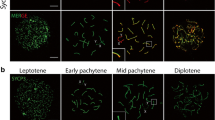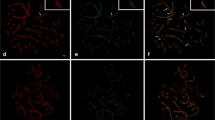Abstract
The possible role of localised pairing as a mechanism producing localised chiasmata in Stethophyma grossum spermatocytes has been examined ultrastructurally. Nuclei at four successive stages of meiosis from leptotene to pachytene were reconstructed from a series of ultrathin sections and the extent of synapsis as demonstrated by synaptonemal complex (SC) formation was calculated. On the basis of the relative lengths of SCs and condensed chromosomes it was reasoned that only the centromeric ends of the long and medium length bivalents paired, and only one end of these SCs was found attached to the nuclear envelope. Only the three shortest bivalents paired completely, and both their SC ends were attached to the nuclear envelope. Thus pairing was directly related to the distribution of chiasmata. The extent of pairing at different stages suggests that the shortest bivalent paired very quickly, the longer ones progressively slower, and that pairing proceeded zip-like from a point at or very close to the end attached to the nuclear envelope, since all stretches of SC were attached to the envelope, and there were never more than 11 pieces, one for each bivalent. Chromosome decondensation and axial core formation did not occur far in advance of SC formation, and synapsis appeared to be much slower in S. grossum than in other species with non-localised chiasmata, as a larger proportion of the meiotic cysts were in “zygotene”, compared to Stauroderus scalaris and Locusta migratoria, although this was not quantified.
Similar content being viewed by others
References
Carpenter, A.T.C.: Electron microscopy of meiosis in Drosophila melanogaster females. II. The recombination nodule — a recombination associated structure at pachytene? Proc. nat. Acad. Sci. (Wash.) 72, 3186–3189 (1969)
Craig Cameron, T.A., Jones, G.H.: Meiosis in Euthystira brachyptera. Ann. Stat. Biologique Besseen-Chandesse 5, 275–292 (1970)
Darlington, C.D.: The internal mechanics of chromosomes. II. Prophase pairing at meiosis in Fritillaria. Proc. roy. Soc. Lond. B 118, 59–73 (1975)
Fletcher, H.L.: An ultrastructural study of chromosome pairing in certain grasshoppers. Ph.D. Thesis, University of East Anglia (1976)
Fox, D.P.: The control of chiasmata distribution in the locust, Schistocerca gregaria (Forskål). Chromosoma (Berl.) 43, 289–328 (1973)
Gillies, C.B.: Reconstruction of the Neurospora crassa pachytene karyotype from serial sections of synaptonemal complexes. Chromosoma (Berl.) 36, 119–130 (1972)
Gillies, C.B.: Ultrastructural analysis of maize pachytene karyotypes by three dimensional reconstruction of the synaptonemal complexes. Chromosoma (Berl.) 43, 145–176 (1973)
Gillies, C.B.: The nature and extent of synaptonemal complexes in haploid barley. Chromosoma (Berl.) 48, 441–453 (1974)
Henderson, S.A.: Chiasmata localisation and incomplete pairing. Chromosomes today 2, 56–60 (1969)
John, B.: Myths and mechanisms of meiosis. Chromosoma (Berl.) 54, 295–325 (1976)
Jones, G.H.: Light and electron microscope studies of chromosome pairing in relation to chiasma localisation in Stethophyma grossum (Orthoptera: Acrididae). Chromosoma (Berl.) 42, 145–162 (1973)
Jones, G.H.: Modified synaptonemal complexes in spermatocytes of Stethophyma grossum. Cold Spr. Harb. Symp. quant. Biol. 38, 109–115 (1973)
LaCour, L.F., Wells, B.: Some morphological aspects of the synaptonemal complex in higher plants. Phil. Trans. roy. Soc. Lond. B 227, 259–266 (1977)
McClung, C.E.: Synapsis and related phenomena in Mecostethus and Leptysma (Orthoptera). J. Morphol. Physiol. 43, 181–285 (1927)
Moens, P.B.: The fine structure of meiotic chromosome polarisation and pairing in Locusta migratoria spermatocytes. Chromosoma (Berl.) 28, 1–25 (1969)
Moens, P.B.: Quantitative electron microscopy of chromosome organisation at meiotic prophase. Cold Spr. Harb. Symp. quant. Biol. 38, 99–107 (1973)
Moses, M.J., Slatton, G.H., Gambling, T.M., Stormer, C.F.: Karyotyping of spermatocytes of Chinese hamster (Cricetulus griseus). III. Quantitative evaluation. Chromosoma (Berl.) 60, 345–376 (1977)
Perry, P.E., Jones, G.H.: Male and female meiosis in grasshoppers. I. Stethophyma grossum. Chromosoma (Berl.) 47, 227–236 (1974)
Rizet, G., Engelmann, C.: Contribution à l'etude génétique d'un ascomycete tetraspore: Podospora anserina. Rev. Cytol. Biol. Veg. 2, 202–304 (1949)
Roberts, I.M.: A method of improving glass knives for cutting ultrathin sections. J. Microscopy 103, 113–120 (1975)
Shaw, D.D.: The supernumerary segment system of Stethophyma. I. Structural basis. Chromosoma (Berl.) 30, 326–343 (1970)
Shaw, D.D.: The supernumerary segment system of Stethophyma. II. Heterochromatin polymorphism and chiasma variation. Chromosoma (Berl.) 34, 19–39 (1971)
Sheriden, W.F., Barnett, R.J.: Cytochemical studies on chromosome ultrastructure. J. Ultrastruct. Res. 27, 216–229 (1969)
Spurr, A.R.: A low viscosity epoxy resin embedding medium for electron microscopy. J. Ultrastruct. Res. 26, 31–43 (1969)
Wallace, B.M.N., Jones, G.H.: Incomplete chromosome pairing in relation to chiasma localisation in Stethopyhma grossum spermatocytes. Heredity (in press, 1977)
Wells, B.: A convenient technique for the collection of ultrathin serial sections. Micron 5, 79–81 (1974)
Westergaard, M., Wettstein, D. von: The synaptinemal complex. Ann. Rev. Genet. 6, 71–110 (1972)
Wettstein, R., Sotelo, J.R.: The molecular architecture of the synaptonemal complex. Advanc. Cell molec. Biol. 1, 109–152 (1971)
White, M.J.D., Morley, F.H.W.: Effects of pericentric rearrangements on recombination in grasshopper chromosomes. Genetics 40, 604–619 (1955)
Zickler, D.: Fine structure of chromosome pairing in ten Ascomycetes: Meiotic and premeiotic (mitotic) synaptonemal complexes. Chromosoma (Berl.) 40, 401–416 (1973)
Zickler, D.: Development of the synaptonemal complex and the “recombination nodules” during meiotic prophase in the seven bivalents of the fungus Sordaria macrospora. Chromosoma (Berl.) 61, 289–316 (1977)
Author information
Authors and Affiliations
Rights and permissions
About this article
Cite this article
Fletcher, H.L. Localised chiasmata due to partial pairing: A 3D reconstruction of synaptonemal complexes in male Stethophyma grossum . Chromosoma 65, 247–269 (1978). https://doi.org/10.1007/BF00327621
Received:
Accepted:
Issue Date:
DOI: https://doi.org/10.1007/BF00327621




